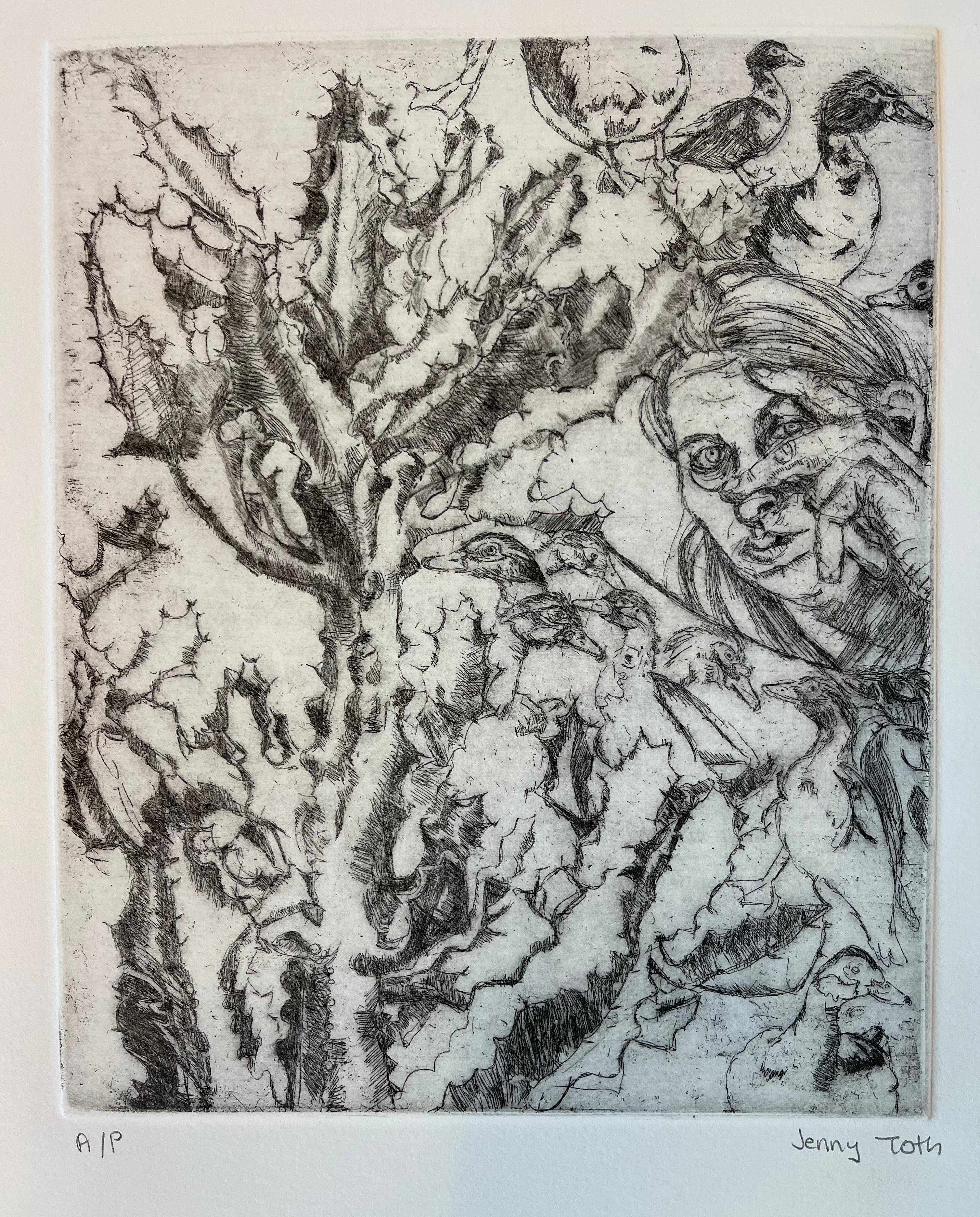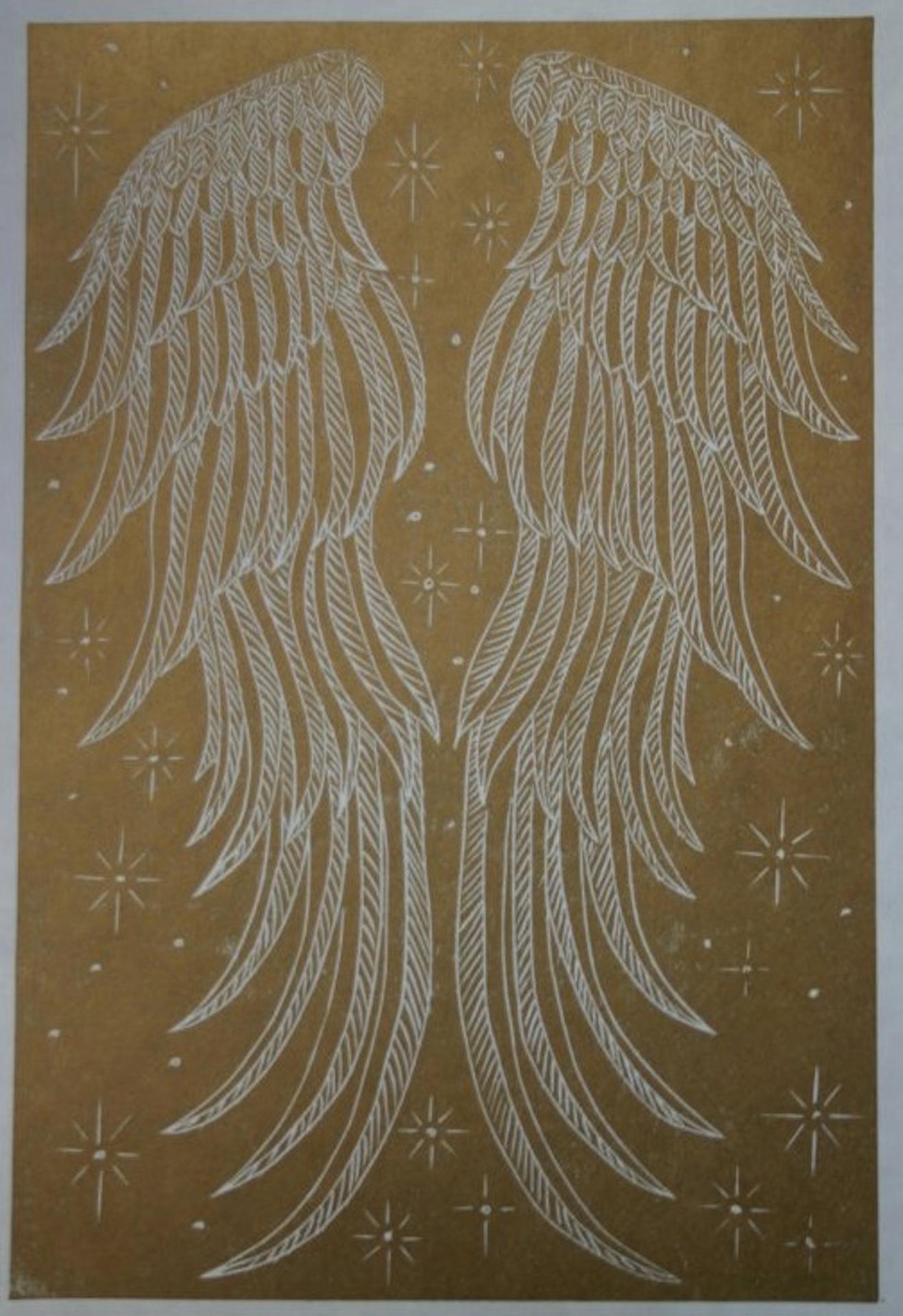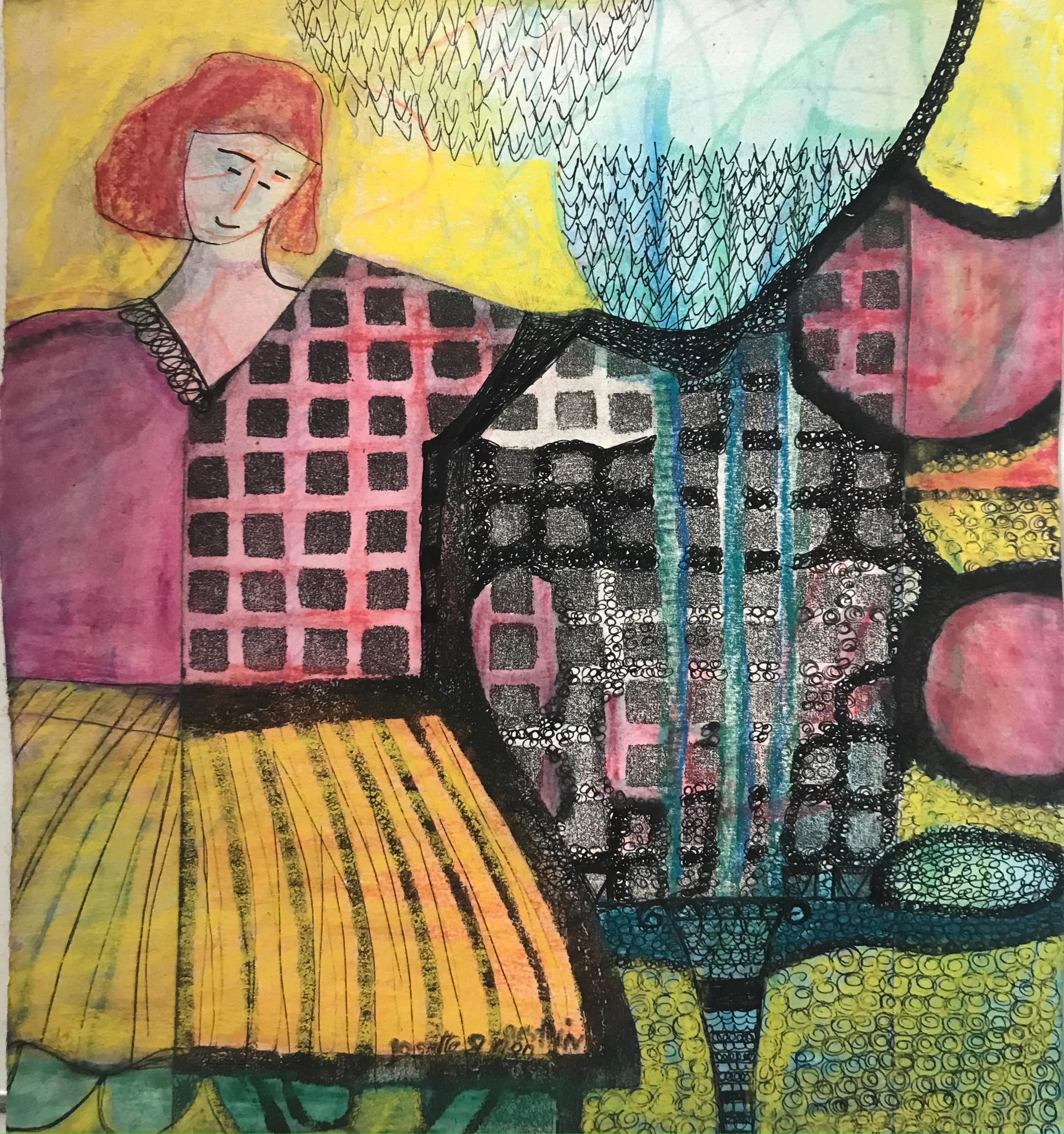Items Similar to Mid Century Battle Of The Sexes Figurative
Want more images or videos?
Request additional images or videos from the seller
1 of 11
Ernest FreedMid Century Battle Of The Sexes Figurative1947
1947
About the Item
Haunting and evocative engraving by Ernest Freed (American, 1908-1974) titled "Battle of the Sexes." Number 21 out of 100. Signed, titled, dated '47 and numbered lower edge. Image size 18.25"H x 29"W. Presented in rustic gilt frame. Measures: 30.50"H x 39"W x 3"D.
With extraordinary passion, skill, innate creativity, and determination, Ernest Freed emerged as an innovative forerunner in the field of mid 20th century visual arts. Within these art forms one finds striking examples of that era's experimentation and growth of modern art of the 1940's through early 1970's, both abstract and figurative. Ernest Freed has especially become known for the developments made in the techniques of "intaglio" engraving and etching, enlarged format, and rich overlay of color in the field of two dimensional printmaking. In an interview The artist stated, "I tend to work a series of plates on themes such as Ballet, the Circus, or Shakespearean themes, to realize symphony of movement and color, repeating and alternating the motif. There is little attention to pictorial representation, but concern in expressing the total emotional response in terms of human form. The artist, and printmaker, has in hand a most trenchant medium, allowing for the expression of profound meanings and relationships in all human emotions." This artist has left the art world an abundant and long lasting legacy, and vision, expressing the spiritual struggles, the joys, and the sorrows and hopes of humanity.
Ernest Freed's artistic training included study at the University of Illinois, the Pennsylvania Academy of Art, and the University of Iowa with nationally known regional painter, Grant Wood, and internationally known printmaker, Mauricio Lasansky, including a strong connection with the Chicago Society of Etchers, and Atelier 17. Freed's career in education included, among others, positions at the University of Iowa, Bradley University, in Illinois, and 20 years as professor of art at Otis Art Institute, in Los Angeles, California. Freed proved early in life to be an extraordinary painter, sculptor, educator, and above all, followed his love for the techniques of printmaking, all with his own personal style. This artist's lifelong creative problem solving process with the elements of the visual arts has been lovingly shared with the world.
His solo exhibitions were held at the Landau Gallery in Los Angeles, Cranbrook Museum, Winnipeg Museum, and Illinois, Iowa, Southern California, and North Carolina University. Repositories of his work include the Smithsonian Institution, Baltimore Museum, Philadelphia Museum, Metropolitan Museum, Brooklyn Museum, Cranbrook Museum, Library of Congress, Los Angeles County Museum of Art, Victoria and Albert Museum, University of Southern California, and the Bibliothèque Nationale.
Ernest Freed passed away in Northridge, California in June of 1974.
- Creator:Ernest Freed (1908 - 1974, American)
- Creation Year:1947
- Dimensions:Height: 30.5 in (77.47 cm)Width: 39 in (99.06 cm)Depth: 3 in (7.62 cm)
- Medium:
- Movement & Style:
- Period:
- Condition:
- Gallery Location:Soquel, CA
- Reference Number:
About the Seller
4.9
Platinum Seller
These expertly vetted sellers are 1stDibs' most experienced sellers and are rated highest by our customers.
Established in 1986
1stDibs seller since 2014
2,519 sales on 1stDibs
Typical response time: <1 hour
- ShippingRetrieving quote...Ships From: Soquel, CA
- Return PolicyA return for this item may be initiated within 14 days of delivery.
More From This SellerView All
- Portrait of a WomanBy Nic JonkLocated in Soquel, CAVibrant portrait of a woman in a blue hat with bright, bold colors by Nic Jonk (Dutch, 1928-1994). Print from the artist's Gallery & Sculpture Garden in Grootschermer, Holland. Displ...Category
1980s Expressionist Figurative Prints
MaterialsFoam Board, Ink, Paper
- Nick's Coffee House in the Village - Rare Edition 1970s Modern Figurative PrintBy Lenore SImonLocated in Soquel, CAThis bold screen print depicts a scene from the 1950s, set in a jazz coffee house in Greenwich Village called Nick's, which Simon patronized while in high school. The original stone ...Category
Late 20th Century Expressionist Figurative Prints
MaterialsArchival Paper, Screen
- "Falling Figures, Decayed State" - Modern Figurative AbstractLocated in Soquel, CAModern abstract etching with hard edges of the printing plate contrasting with the soft dark gray tones inside the figurative centerpiece. Titled "Falling Figures, Decayed State", "E...Category
1970s Modern Figurative Prints
MaterialsPrinter's Ink, Archival Paper, Etching
- Mid Century Figural Abstract -- Rock with Teapot Jelly FishBy Dean SnyderLocated in Soquel, CAStunning figural abstract silkscreen titled "Rock" by Dean Snyder (American, b. 1953). Artist's Proof 1990. Titled, signed and dated lower edge. Presented in mat, unframed. Image Si...Category
1990s Abstract Abstract Prints
MaterialsArchival Paper, Ink
- "Bessie Smith" - Musician's Portrait Etching on Paper (A/P)Located in Soquel, CA"Bessie Smith" - Musician's Portrait Etching on Paper (A/P) Clean and modern drypoint etching of a jazz singer Bessie Smith by Maria Bennett (American, 20th Century). The singer is ...Category
1970s Modern Portrait Prints
MaterialsPaper, Ink, Drypoint
- Study of Utagawa Hiroshige's "View of Hara-Juku" 53 Stations of the Tokaido RoadBy Utagawa HiroshigeLocated in Soquel, CAStudy of Utagawa Hiroshige's "View of Hara-Juku" 53 Stations of the Tokaido Road Hand painted study of Utagawa Hiroshige's "View of Hara-Juku", (by unknown artist), from "53 Station...Category
1920s Edo Landscape Prints
MaterialsWoodcut, Paper, Ink
You May Also Like
- Ducks Quacking, Cactus Peeking, linear style, monochromaticBy Jenny TothLocated in Brooklyn, NYThis is an artist proof aquatint of a woman peeking around a cactus with ducks mysteriously hovering in the upper right corner and a giant beautiful cactus overgrowing. The mood is ...Category
2010s Expressionist Figurative Prints
MaterialsPaper, Ink, Archival Ink, Aquatint
- Transcend, Kate Willows, Limited Edition Print, Angelic Artwork, Affordable ArtLocated in Deddington, GBTranscend by Kate Willows [2017] limited edition Ink on paper Edition of 40 Image size: H:30 cm x W:20 cm Sold Unframed Please note that insitu image...Category
21st Century and Contemporary Expressionist Portrait Prints
MaterialsPaper, Ink
- Félix Vallotton ( Swiss 1865 - 1925) L’Exécution Woodcut 18/25 , SwitzerlandBy Félix VallottonLocated in Meinisberg, CHFélix Vallotton (Swiss, 1865 - 1925) L’Exécution • Wood cut print • Loose Japan paper sheet, 25 x 37 cm • Block, ca. 15 x 25 cm • Monogrammed in the ...Category
1890s Expressionist Figurative Prints
MaterialsPaper, Ink, Woodcut
- 'No way back 4, ' by Josette Simon Gestin, Mixed Media DrawingBy Josette Simon-GestinLocated in Oklahoma City, OKThis 11.5" X 10.5" unframed mixed media pastel and ink etching on paper by Josette Simon Gestin is from the artist's series titled "No way back." On the ...Category
2010s Expressionist Figurative Prints
MaterialsPaper, Pastel, Ink, Mixed Media
- H.O. Miethke Das Werk folio "Judith I" collotype printBy Gustav Klimt & K.K. Hof-und StaatsdruckereiLocated in Chicago, ILJudith I, no. 9 from the second installment of Das Werk Gustav Klimts Much like his treatment of the Classical personage, Danae, from Greek mythology, Klimt’s depiction of Judith takes an Old Testament character, a heroine who avenges the death of her husband by killing an Assyrian king, and firmly positions her in his present-day Vienna. His multicolored collotype rips the canvas from its gilded frame which directly references the subject with its title: “Judith und Holofernes”. Now in print form, Judith, holding the severed head of a male in murky shadow, is the ultimate Viennese femme fatale. Her likeness is unmistakably similar to a former lover of Klimt’s and famous Viennese soprano, Anna von Mildenburg. Though his allusion to ancient Assyria is apt, Klimt literally lifted the gold patterned background’s design motif from a relief detail from Sennacherib’s Palace displayed in a London museum. His context then is contemporary. In a sensual and sexually powerful tour de force, Klimt’s Judith...Category
Early 1900s Vienna Secession Figurative Prints
MaterialsPaper, Ink
- H.O. Miethke Das Werk folio "The Sisters" collotype printBy Gustav Klimt & K.K. Hof-und StaatsdruckereiLocated in Chicago, ILDAS WERK GUSTAV KLIMTS, a portfolio of 50 prints, ten of which are multicolor collotypes on chine colle paper laid down on hand-made heavy cream wove paper with deckled edges; under each of the 50 prints is a gold signet intaglio printed on the cream paper each of which Klimt designed for the publication as unique and relating to its corresponding image; H.O. Miethke, Editor-Publisher; k.k. Hof-und Staatsdruckerei, Printer; printed in a limited edition of 300 numbered plus several presentation copies; Vienna, 1908-1914. The idea of collaboration in the arts is anything but new; however it has so often been viewed and assessed as somehow devaluing the intrinsic worth of art. It’s as if it was a dirty secret to be hidden away. More so even than the eroticism explored by Klimt, which divided public opinion, the artistic avant-garde began to boldly flaunt artistic collaboration beginning in the 19th century- which gained steam in the first part of the 20th century- to become a driving vehicle of contemporary artistic creation. Viewed in this context, the folios of collotype prints published by H.O. Miethke in Vienna between 1908-1914 known as Das Werk Gustav Klimts, are important art documents worthy of as much consideration for their bold stand they take on established ways of thinking about artistic collaboration as they are for their breathtakingly striking images. 1908 is indeed a watershed moment in the history of art. To coincide with the 60th anniversary of the reign of Emperor Franz Joseph I, Kunstschau opened in Vienna in May of that year. It was there that Klimt delivered the inaugural speech. Speaking about the avant-garde group’s unifying philosophy of Gesamtkunstwerk, or the synthesis of the arts, Klimt shared his belief that the ideal means to bring artists and an audience together was via “work on major art projects.” It was at Kunstschau 1908 that Klimt first exhibited his most iconic painting, The Kiss, as well as The Sunflower, Water Snakes I and II and Danae. It was at Kunstschau 1908 that Das Werk Gustav Klimts was first available for purchase. Thanks to Galerie Miethke’s organization, Kunstschau 1908 was possible. Miethke’s pioneering art house had become Klimt’s exclusive art dealer and main promoter of his modernist vision. Paul Bacher and Carl Moll, a founding member with Klimt of the Vienna Secession, who all broke away during the rift in 1905, took stewardship of the gallery following the fallout with the Secession. Das Werk Gustav Klimts is a prime example of Miethke’s masterful and revolutionary approach to marketing art. Miethke’s innovative marketing strategy played to a penchant for exclusivity. The art gallery and publishing house utilized the press and art critics- such as Austria’s preeminent Art Historian, Hugo Haberfield, who became Director of the gallery in 1912- as a means of gaining publicity as well as maintaining effective public relations. Miethke used the grand exposition format to extend the art gallery’s market reach, cultivating their product’s prestige by stroking the egos of current art patrons while simultaneously creating accessibility for newcomers and others avid collectors to share a relative proximity to other wealthy and respected members of the art collecting community. Essentially, their approach paved the way for what is still the predominant means of marketing. Between 1908 and 1914, H.O. Miethke published a total of 5 installments of print folios of Klimt’s painted work, each comprising 10 prints. The series was limited in availability to 300 and purchase was arranged through subscription. Each issue was presented unbound in a gold embossed black paper folder. Included in the folio was a Title Page, a Justification page and a Table of Contents page itemizing each of the 10 printed works with details about their corresponding painted works as well as information about each work’s current owner. These folios were not comprehensive of Klimt’s work; but rather, they feature what he believed were his most important paintings from 1898-1913. Only 2 collotypes in each folio were multicolored. To punctuate the fact that Klimt, himself, was very much an active player in creating these printed works, he created square-shaped signets, unique to each collotype which were intaglio printed in gold ink at the bottom of the cream wove papers to which the chine collie papers were affixed.These signets relate thematically to their corresponding printed images and designate each of those images by their placement in the folio’s Table...Category
Early 1900s Vienna Secession Figurative Prints
MaterialsArchival Paper
Recently Viewed
View AllMore Ways To Browse
North Carolina Mid Century
Battle Field
Little Albert
Engraving Battle
Ballet Plate
Circus Plate
Bradley Wood
Signed Meaning In Printmaking
Atelier Archive Vintage
Circus Etching
Vintage Circus Plates
Battle Of Brooklyn
Ballet Winnipeg
Le Palais Royal
Ballet Costume Drawing
Vintage Square Dance
Vintage Square Dancing
Vintage Fancy Frames





